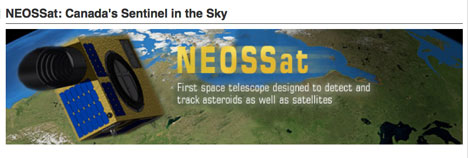
The Honourable Christian Paradis, Minister of Industry and Minister responsible for the Canadian Space Agency (CSA), today celebrated the successful launch of the Canadian space telescope, the Near-Earth Object Surveillance Satellite (NEOSSat). NEOSSat launched at 7:31 (EST) from Sriharikota, India aboard a Polar Satellite Launch Vehicle (PSLV) rocket together with Department of National Defence’s satellite Sapphire.
“Today marks another milstone for Canada’s world renowned space sector. This microsatellite is a testament to Canadian ingenuity and leadership in advanced space technology,” said Minister Paradis. “Our Government will continue to support the development of this vital sector to ensure it can continue to foster innovative technologies and create high-quality jobs for Canadians.”
Known as Canada’s “Sentinel in the Sky”, NEOSSat is the world’s first experimental microsatellite designed to detect and track space objects, debris and satellites. Funded and managed jointly by the Canadian Space Agency (CSA) and Defence Research and Development Canada (DRDC), NEOSSat will perform multiple tasks, while carrying out two distinct missions serving the needs of the science and defence communities.
“Today’s successful launch is a great accomplishment made possible by Canadian specialized expertise and technology that has literally pushed the boundaries of innovation. As NEOSSat becomes fully operational, the satellite will provide us with key data and imagery from the unique vantage point of space to become our Sentinel in the Sky” said Gilles Leclerc, Acting President of the CSA.
The suitcase-sized NEOSSat will orbit approximately 800 kilometres above the Earth, searching for near-Earth asteroids and space objects that are difficult to spot using ground-based telescopes. Because of its location, NEOSSat will not be limited by the day-night cycle and will operate 24/7. For more details about the microsatellite NEOSSat, visit.

